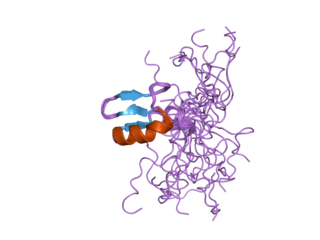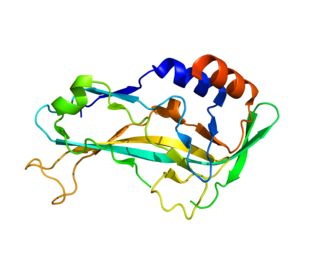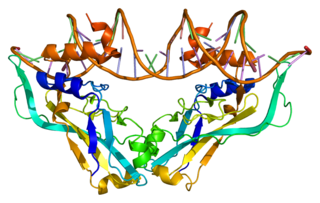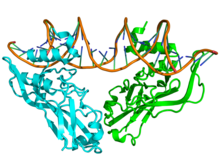
T-box transcription factor TBX1 also known as T-box protein 1 and testis-specific T-box protein is a protein that in humans is encoded by the TBX1 gene. Genes in the T-box family are transcription factors that play important roles in the formation of tissues and organs during embryonic development. To carry out these roles, proteins made by this gene family bind to specific areas of DNA called T-box binding element (TBE) to control the expression of target genes.

T-box transcription factor T, also known as Brachyury protein, is encoded for in humans by the TBXT gene. Brachyury functions as a transcription factor within the T-box family of genes. Brachyury homologs have been found in all bilaterian animals that have been screened, as well as the freshwater cnidarian Hydra.

Zinc finger protein GLI3 is a protein that in humans is encoded by the GLI3 gene.

Paired box protein Pax-6, also known as aniridia type II protein (AN2) or oculorhombin, is a protein that in humans is encoded by the PAX6 gene.

Holt–Oram syndrome is an autosomal dominant disorder that affects bones in the arms and hands and often causes heart problems. The syndrome may include an absent radial bone in the forearm, an atrial septal defect in the heart, or heart block. It affects approximately 1 in 100,000 people.

The autoimmune regulator (AIRE) is a protein that in humans is encoded by the AIRE gene. It is a 13kb gene on chromosome 21q22.3 that has 545 amino acids. AIRE is a transcription factor expressed in the medulla of the thymus. It is part of the mechanism which eliminates self-reactive T cells that would cause autoimmune disease. It exposes T cells to normal, healthy proteins from all parts of the body, and T cells that react to those proteins are destroyed.

Limb development in vertebrates is an area of active research in both developmental and evolutionary biology, with much of the latter work focused on the transition from fin to limb.
The limb bud is a structure formed early in vertebrate limb development. As a result of interactions between the ectoderm and underlying mesoderm, formation occurs roughly around the fourth week of development. In the development of the human embryo the upper limb bud appears in the third week and the lower limb bud appears four days later.

Transcription factor 4 (TCF-4) also known as immunoglobulin transcription factor 2 (ITF-2) is a protein that in humans is encoded by the TCF4 gene located on chromosome 18q21.2.

Chromodomain-helicase-DNA-binding protein 7 also known as ATP-dependent helicase CHD7 is an enzyme that in humans is encoded by the CHD7 gene.

Fibroblast growth factor 10 is a protein that in humans is encoded by the FGF10 gene.

T-box transcription factor TBX5, is a protein that in humans is encoded by the TBX5 gene. Abnormalities in the TBX5 gene can result in altered limb development, Holt-Oram syndrome, Tetra-amelia syndrome, and cardiac and skeletal problems.

T-box transcription factor TBX3 is a protein that in humans is encoded by the TBX3 gene.

Sal-like protein 4(SALL4) is a transcription factor encoded by a member of the Spalt-like (SALL) gene family, SALL4. The SALL genes were identified based on their sequence homology to Spalt, which is a homeotic gene originally cloned in Drosophila melanogaster that is important for terminal trunk structure formation in embryogenesis and imaginal disc development in the larval stages. There are four human SALL proteins with structural homology and playing diverse roles in embryonic development, kidney function, and cancer. The SALL4 gene encodes at least three isoforms, termed A, B, and C, through alternative splicing, with the A and B forms being the most studied. SALL4 can alter gene expression changes through its interaction with many co-factors and epigenetic complexes. It is also known as a key embryonic stem cell (ESC) factor.

T-box transcription factor 2 Tbx2 is a transcription factor that is encoded by the Tbx2 gene on chromosome 17q21-22 in humans. This gene is a member of a phylogenetically conserved family of genes that share a common DNA-binding domain, the T-box. Tbx2 and Tbx3 are the only T-box transcription factors that act as transcriptional repressors rather than transcriptional activators, and are closely related in terms of development and tumorigenesis. This gene plays a significant role in embryonic and fetal development through control of gene expression, and also has implications in various cancers. Tbx2 is associated with numerous signaling pathways, BMP, TGFβ, Wnt, and FGF, which allow for patterning and proliferation during organogenesis in fetal development.

T-box transcription factor TBX22 is a protein that in humans is encoded by the TBX22 gene.

T-box, brain, 1 is a transcription factor protein important in vertebrate embryo development. It is encoded by the TBR1 gene. This gene is also known by several other names: T-Brain 1, TBR-1, TES-56, and MGC141978. TBR1 is a member of the TBR1 subfamily of T-box family transcription factors, which share a common DNA-binding domain. Other members of the TBR1 subfamily include EOMES and TBX21. TBR1 is involved in the differentiation and migration of neurons and is required for normal brain development. TBR1 interacts with various genes and proteins in order to regulate cortical development, specifically within layer VI of the developing six-layered human cortex. Studies show that TBR1 may play a role in major neurological diseases such as Alzheimer's disease (AD), Parkinson's disease (PD) and autism spectrum disorder (ASD).

T-box 6 is a protein that in humans is encoded by the TBX6 gene.
T-box transcription factor Tbx4 is a transcription factor that belongs to T-box gene family that is involved in the regulation of embryonic developmental processes. The transcription factor is encoded by the TBX4 gene located on human chromosome 17. Tbx4 is known mostly for its role in the development of the hindlimb, but it also plays a critical role in the formation of the umbilicus. Tbx4 has been shown to be expressed in the allantois, hindlimb, lung and proctodeum.

T-box transcription factor TBX15 is protein that is encoded in humans by the Tbx15 gene, mapped to Chromosome 3 in mice and Chromosome 1 in humans. Tbx15 is a transcription factor that plays a key role in embryonic development. Like other members of the T-box subfamily, Tbx15 is expressed in the notochord and primitive streak, where it assists with the formation and differentiation of the mesoderm. It is steadily downregulated after segmentation of the paraxial mesoderm.


















